Dear Readers In the ever-evolving automotive industry, dealerships are constantly seeking innovative strategies to optimize profitability and sustainability. One such approach gaining momentum is the concept of multi-brand automobile dealerships—retail spaces that offer vehicles from multiple manufacturers under one roof. This model presents several financial and operational advantages, enabling dealerships to enhance their revenue streams, improve customer experience, and achieve greater economies of scale. This article delves into the dynamics, benefits, and impact of multi-brand dealerships on overall profitability, supplemented with real-world examples of successful implementation.
The Dynamics of Multi-Brand Automobile Dealerships
A multi-brand automobile dealership operates by securing agreements with multiple Original Equipment Manufacturers (OEMs) to sell a variety of vehicle brands within the same dealership network. The dealership must adhere to each brand’s specific guidelines, from showroom layouts to marketing requirements. These dealerships often categorize their showrooms into distinct sections per brand while leveraging shared services, such as aftersales support, financing, and administration.
Key operational dynamics include:
- Brand-Specific Compliance: Ensuring each brand’s identity is maintained while optimizing resource utilization.
- Inventory Management: Balancing stock levels across multiple brands to align with demand.
- Salesforce Training: Equipping sales and service personnel with expertise across various brands.
- Customer Segmentation: Catering to a diverse customer base with varying brand preferences.
- Aftermarket Services: Establishing a robust service network that meets the distinct requirements of multiple manufacturers.
Advantages of Multi-Brand Automobile Dealerships
1. Diversification of Revenue Streams
One of the primary advantages of multi-brand dealerships is the ability to diversify revenue sources. Offering multiple brands allows dealers to tap into various customer segments, from budget-conscious buyers to luxury seekers. This model helps mitigate risks associated with market fluctuations affecting a single brand.
2. Increased Footfall and Customer Retention
A broader selection of brands attracts a wider customer base, increasing showroom traffic. Potential buyers exploring different options within a single dealership are more likely to make a purchase. Moreover, customers who trust the dealership’s service center for one brand may be inclined to consider other brands available within the same network.
3. Improved Inventory Turnover
A dealership that stocks multiple brands has greater flexibility in managing inventory. For example, if one brand experiences slower sales, the dealership can offset this with the sales of another brand’s popular models. This balanced approach optimizes inventory turnover and reduces holding costs.
4. Economies of Scale and Cost Efficiency
By sharing operational expenses such as marketing, administration, and aftersales support across multiple brands, multi-brand dealerships benefit from economies of scale. Consolidating overhead costs enables higher profitability without significantly increasing operational expenses.
5. Enhanced Competitive Edge
In an industry where competition is fierce, a multi-brand approach helps dealerships stand out. Customers prefer dealerships where they can compare multiple options before making a decision. This positioning fosters a competitive advantage over single-brand dealerships that might not offer the same variety.
6. Stronger Negotiating Power with OEMs
Multi-brand dealers often possess greater bargaining power when negotiating terms with manufacturers. OEMs recognize the dealership’s ability to push multiple brands and may offer better incentives, promotional support, and inventory financing options.
7. Resilience Against Market Downturns
During economic downturns, demand for vehicles from a single brand may decline. However, with a diversified portfolio, multi-brand dealerships can continue generating revenue by capitalizing on brands that experience steady demand. This diversification ensures business continuity even in challenging market conditions.
Case Studies of Successful Multi-Brand Dealerships
1. Penske Automotive Group (United States and International)
Penske Automotive Group is a prime example of a successful multi-brand dealership model. Operating over 300 dealerships across multiple countries, Penske represents brands such as BMW, Audi, Toyota, and Mercedes-Benz. Their strategy focuses on premium customer service, efficient inventory management, and strong OEM partnerships, contributing to consistent profitability.
2. Inchcape PLC (United Kingdom and International)
Inchcape, a UK-based automotive retailer, represents brands like Jaguar Land Rover, Lexus, and Volkswagen. Their multi-brand strategy allows them to cater to luxury and mass-market segments simultaneously, creating a balanced revenue stream. Inchcape’s robust online presence and customer-centric service model further amplify its success.
3. Al-Futtaim Automotive (Middle East & Asia)
Al-Futtaim Automotive, based in the UAE, manages multiple automotive brands, including Toyota, Honda, and Volvo. Their approach integrates shared service centers and aftersales support, leading to cost efficiencies and enhanced customer satisfaction. By leveraging strategic partnerships with OEMs, Al-Futtaim has maintained strong market positioning.
4. Group 1 Automotive (United States)
Group 1 Automotive operates a network of dealerships with multiple brands, focusing on a mix of luxury and mainstream vehicles. Their success lies in effective customer relationship management (CRM) systems, which help them personalize interactions across different brand segments.
Challenges and Considerations
While the multi-brand model offers substantial benefits, it also presents unique challenges:
- Brand Identity Management: Maintaining distinct brand identities within a shared dealership space can be complex.
- OEM Relations: Managing relationships with multiple manufacturers requires balancing different contractual obligations and compliance requirements.
- Training Complexity: Sales and service teams must be well-versed in various brand specifications and technological advancements.
- Initial Capital Investment: Establishing a multi-brand dealership often requires significant upfront investment in infrastructure, personnel, and marketing.
Conclusion:
The multi-brand automobile dealership model is an effective strategy for enhancing profitability and long-term sustainability. By diversifying revenue streams, optimizing operational costs, and enhancing customer experience, dealerships can position themselves for success in a competitive automotive market. However, to fully capitalize on this approach, dealerships must implement strong management practices, invest in workforce training, and foster strong relationships with OEMs.
As demonstrated by successful dealership groups worldwide, a well-executed multi-brand strategy can yield significant financial and operational benefits. With the right balance of inventory management, customer engagement, and cost control, multi-brand dealerships can drive long-term growth and profitability, making them an attractive business model for the future of automotive retail.
This exclusive article has been published in Automark’s March-2025 printed and digital edition. Written by Aqeel Bashir










